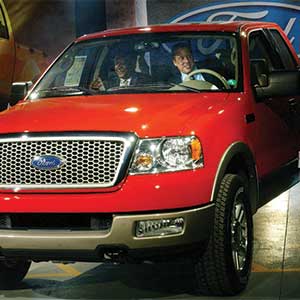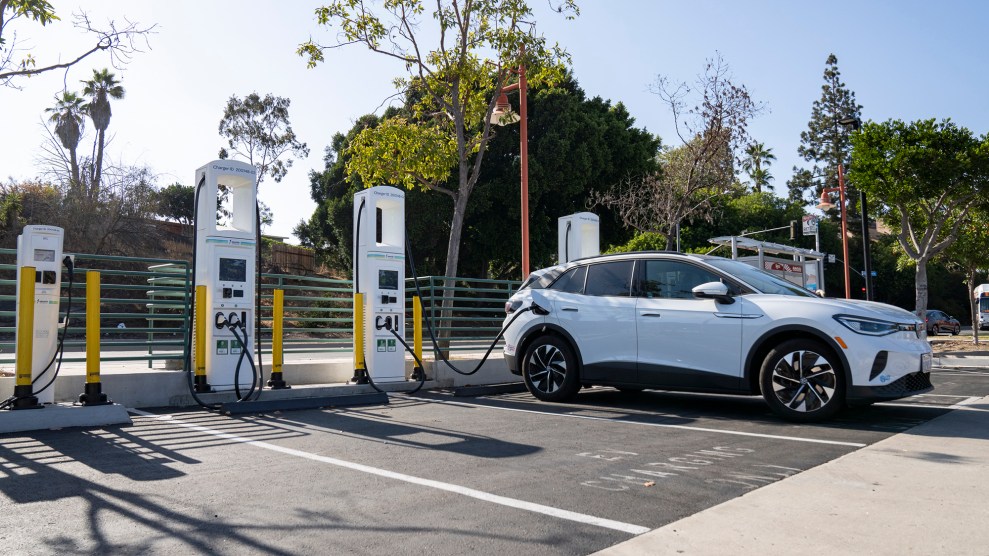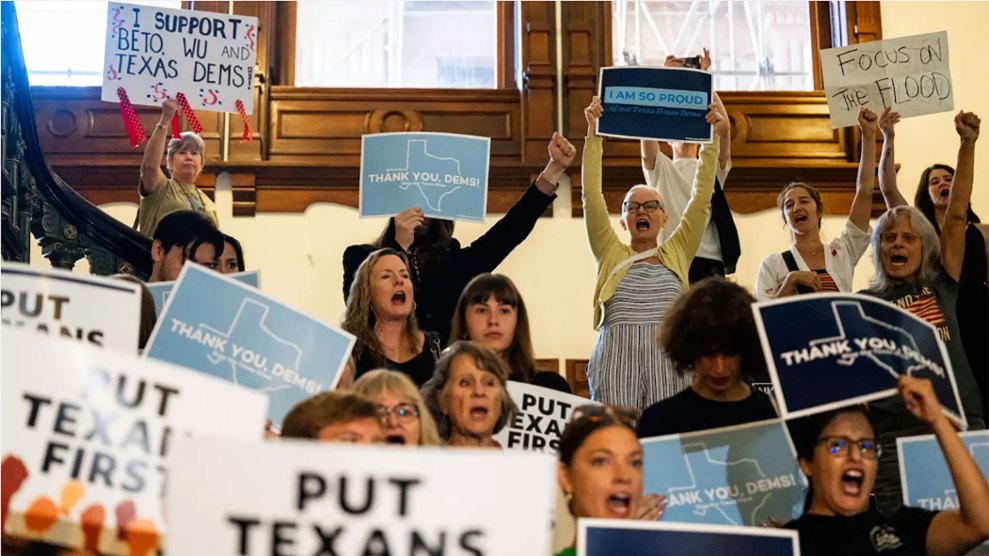
Photo: Rebecca Cook/Reuters
On july 27, 2000, Jacques Nasser, then president and ceo of the Ford Motor Company, stood before a packed audience at the National Press Club and made a surprising declaration. Ford, he pledged, would boost the fuel economy of its suvs by 25 percent within five years. Reporters scribbled furiously as Nasser spoke; this was not the sort of thing anyone in Detroit went around promising, least of all America’s most iconic automaker, flush with profits from its big trucks and suvs and a recent victory putting the kibosh on tougher federal mileage standards.
Then again, no other company had a chairman quite like William Clay Ford Jr. A self-described environmentalist, Bill Ford was fighting a dramatic battle to transform his great-grandfather’s company into a model of sustainability. (Full disclosure: I was a Ford media liaison for six months in 2000.) Unlike other auto execs, he acknowledged the problem of global climate change and his industry’s role in it. He drove an electric Ford Ranger truck and successfully launched a $2 billion renovation that made the company’s Rouge assembly plant one of the industry’s greenest. He talked up fuel efficiency and promised to expand hybrid production. “There is a rising tide of environmental awareness and activism among consumers that is going to swell to undreamed-of heights in the 21st century,” Ford told Automotive News after being named chairman-elect in September 1998. “Smart companies will get ahead of that wave, and ride it to success and prosperity. Those that don’t are headed for a wipeout.”
But if outsiders were impressed with Nasser’s “25 by 5” announcement, many within the company saw the project as doa. Jim Schroer, then Ford’s global marketing chief, had first heard about it two months earlier at an executive test-drive of a prototype tricked out for fuel efficiency. “I’m sitting there, and I think, ‘Oh boy, that’s not going to happen,'” he recalls. Sure, Ford knew what it would take—the necessary technologies, such as ultralight carbon-fiber parts and advanced electronics, had all been tested by its labs—but adding those features would cost more, and Schroer didn’t think American consumers would put up with that. “By anybody’s financial present-value calculation, you’d be crazy to do it,” he says.
In hindsight, of course, it seems Ford was crazy not to. As Schroer predicted, Nasser’s pledge fizzled due to its price tag, and despite a decade of environmental prophesying by its chairman, the Ford Motor Company is only now beginning to view matters like fuel efficiency as business imperatives. In July, battered by soaring gas prices and plummeting sales, Ford announced that it would slash production of the trucks that have been its lifeblood—from half of its vehicles today (and 70 percent in 2005) to about one-third by 2012. To replace them, it will adopt a number of its small European models, some to be assembled in plants that once built the F-Series trucks, until recently the nation’s top-selling vehicles. Alan Mulally, Ford’s current ceo, will also speed up launch of the Ford Fusion and Mercury Milan hybrids, and double overall hybrid production to 50,000 units in 2009—impressive until you consider that it represents less than 2 percent of Ford’s 2007 US sales.
Is it too little, too late? “They did squander an opportunity,” says Mindy Lubber, president of Ceres, a green-business coalition of which Ford is a member. “If the company had followed what [Bill Ford] wanted they wouldn’t have had to make these changes in the 11th hour. They could have been out there in front. They could have gained market share.”
But what happened at Ford is more than just a Wall Street campfire story. Perhaps no other company so embodies the difficulties America faces as we confront a growing energy crisis and the urgent reality of climate change. If a well-intentioned leader whose family owns 40 percent of the company’s voting stock can’t make lasting changes, then who can? Change is an easy sell when a company is in free fall, but overcoming marketplace myopia during better times requires long-term vision, a strategic business plan, and the ability to sell them both—not only to consumers, but to corporate stakeholders, whether gas costs $5 a gallon or 89 cents.
A gallon of regular, in fact, was retailing for less than a buck when Bill Ford began his term as chairman in January 1999. Ford trucks were selling like mad, and the company was on an acquisition binge. During the chairman’s first year, Ford hauled in more money than any car company ever had: a $7.2 billion profit on sales of $163 billion. Its 25 percent US market share put Ford within reach of General Motors, the world’s top vehicle manufacturer. (Earlier this year, Ford’s market share fell to around 15 percent, putting it well behind Toyota.)
In theory, the gangbuster sales should have given executives leeway to experiment. Bill Ford also had Nasser, a president and ceo 10 years his senior with the clout to implement his vision. Former company executives say there’s a reason Nasser, not Ford, announced the fuel-economy initiative: “Nobody dared defy him,” one of them recalls. “Nobody was afraid of Bill Ford.”
Indeed, nearly everyone I spoke with—from auto executives and industry analysts to environmentalists and activist shareholders—agreed that no matter his personal convictions, Bill Ford had neither the operational skills nor the management talent to make his green aspirations a reality. Instead, the chairman tried to tack environmental changes onto a business model focused obsessively on bigger, badder trucks—Built Ford Tough. “Bill is a very idealistic guy, very principled,” says David Cole, chair of the Center for Automotive Research in Ann Arbor, Michigan, and a longtime informal adviser to Ford and other automakers. “But he was relatively young and he had never been in the trenches. Now all of a sudden he is captain of a ship and he hadn’t been in the engine room…Ultimately, that kept his wish from being fulfilled.”
The company also had serious organizational problems. Many of its plants were inflexible, designed to make just one type of vehicle. And Ford usa, while still profitable, was an island in an increasingly globalized world. Toyota and other rivals were able to build vehicles that sold anywhere, but Ford operations in North America, Europe, Asia, and South America shared little more than a logo. Even that was contentious, Schroer recalls. “It took two years to agree that we should use the same Ford oval for the planet. That’s how separatist it was.”
To compete, the company needed to collapse its far-flung operations into a single, global company. This would have allowed Ford to bring fuel-efficient models to the US market far more quickly and spread efficiency technologies across its product lines, reducing the unit cost and giving its chairman a better business case for his vision. But it didn’t happen.
Nasser and Ford (both men declined to be interviewed for this article) treated one another respectfully, according to those who worked with them, but they clashed over the company’s direction. Nasser saw himself as a corporate change maker on the order of GE’s Jack Welch. He wanted a Ford built on brands and responsive to consumer desires, which in his world meant nifty electronics like navigation systems and satellite radio, and a hip aesthetic; he promoted J Mays, designer of Volkswagen’s popular Beetle remake, to give new life to the brand. (Slogan for Ford’s new Flex, an suv-like seven-seater: “For people in search of stimulation.”) Far from integrating Ford’s global operations, Nasser further balkanized them, buying up Sweden’s Volvo and the British Land Rover. On his watch, the company even branched out into e-commerce, junkyards, and auto-repair shops.
As Nasser barreled ahead, Bill Ford neither constrained him nor did he put forward his own viable business plan. “He didn’t have their respect,” one former executive says of Ford. “He’s the name on the building…He never had the business credibility with the decision makers for them to ever take him seriously.”
Bill ford’s—indeed, the company’s—greatest environmental accomplishment has been the Rouge factory overhaul. The rebuilt plant has one of the world’s largest living roofs, plus solar cells and skylights to reduce lighting costs. Rouge now serves as a benchmark for Ford’s other factories; overall the automaker has reduced energy use by 30 percent and trimmed emissions from its manufacturing facilities by 39 percent since 2000, boasts John Viera, the company’s director of sustainable business strategies. However, as Jennifer Krill of the Rainforest Action Network points out, “They are still building F-150s under that green roof.” Indeed, on the product end, top executives viewed their chairman’s vision as a “nice thing to do,” according to one insider—not as a must-have for the company’s future.
“The premise of what Bill Ford did, and it tends to be the premise that a lot of corporate environmentalists take, comes from a kind of noblesse oblige approach. It’s about what we will deign to do,” says John DeCicco, a senior fellow with the Environmental Defense Fund who has long been involved with automotive issues. “The ’25 by 5′ pledge is a very instructive story because it really points out the inability of the individual corporate actor to go in a different direction from where the competitive marketplace wants to go.”
In fact, when Nasser announced Ford’s fuel-economy plan, environmentalists wondered whether the company had even considered how it would pull it off. “What they always said to me is, ‘Look, we chose a goal somewhat arbitrarily in order to please people like you,'” says Dan Becker, former director of the Sierra Club’s global warming program, who attended Nasser’s National Press Club speech.
“Bottom line,” says Viera, who back then was a chief engineer on Ford’s Ranger pickup, “the cost of the technologies at that point wasn’t aligned with the price the customer was willing to pay. So we didn’t have any business case at all.”
There was indeed a business case. It just happened to be a long-term one. But even if top executives had been listening, a series of crises kept them distracted, allowing competitors to take the lead in fuel efficiency and global strategy alike. First came the Firestone tire fiasco of 2000; next was 9/11, which hit the industry hard. Seven weeks later, with Ford on track to lose $5.5 billion, the board fired Nasser. Bill Ford himself took over as chief executive just as Nasser’s late-1990s acquisitions and the company’s global shortcomings began to cause major problems. “Fires were raging everywhere,” Ford later told Newsweek.
Lacking clear direction, Ford usa reverted to what it knew best: making and selling powerful trucks, which made the company profitable for a couple more years. But the writing was on the wall. Ford’s Escape Hybrid suv didn’t hit the market until 2004, five years after Honda’s Insight first appeared on US dealers’ lots. And while Toyota has been selling hybrid cars in the US for almost a decade, Ford won’t have its first one on the market until 2009. Ford didn’t even have much of a conventional small-car business to fall back on when US consumers pulled a U-turn.
By 2006, Bill Ford was desperate, admitting to auto consultant Cole that “I’m over my head.” And he was. The company lost $12.7 billion that year, its biggest hit ever, and Ford was looking to cut tens of thousands of workers.
That September, Ford reached outside the company to hire Alan Mulally, then a top Boeing exec, as the new ceo. Since coming on board, Mulally has overhauled corporate structure, integrated global operations, and accelerated plans to bring over small cars from Europe. The Fiesta and five other models, some smaller than the Ford Focus, will hit US roads by the end of 2012; in the interim, the company expects to bleed more cash, adding to its nearly $23 billion in losses over the past two years. Ford doesn’t predict a return to profitability until after the small cars start rolling out in America.
Publicly, Bill Ford pinned his failure on consumer behavior. The market had demanded bigger and bigger vehicles despite his warnings, so that’s what Ford provided. “Gasoline prices were cheap,” he recently told a columnist for Business Week, “and customers were buying many more of our big F-150s than they were of our Escape hybrids. Now everyone’s aligned behind this [fuel-efficiency] vision.”
The subtext, of course, is that public companies are slaves to short-term consumer demand. “The conventional wisdom of financials never, ever directs you to investments that pay off in years five through ten,” notes Schroer, Ford’s former marketing chief. “Would it be the economically rational thing to bring small cars here years ago? Hell no, not when every one you bring over here is less profitable than selling a big truck.”
Indeed, selling Priuses in the US was a money-losing proposition for Toyota at first—but now the Japanese carmaker is reaping the benefits. “I don’t see any evidence that any of the companies are motivated by environmental goals,” says Dan Becker, who now runs the Safe Climate Campaign. “I don’t see it in Honda, and I don’t think Toyota does it either.” But when these companies look at their bottom lines, Becker adds, they see the need to invest for the long term.
Mulally has given sustainability top billing in the Ford hierarchy, promoting a senior vice president to oversee it, and Viera leads a four-person corporate sustainability team. That Ford plucked him, a truck guy, to handle the new push, Viera says, shows that the company is getting serious. “My previous 22-plus years were all on the product-development side, from trucks [to] large suvs,” he says. “I’ve had a lot of experience driving concepts into production and into reality.” He’s also well aware of the pitfalls.
Ford’s most recent sustainability report lays out a blueprint for reducing its new cars’ CO2 emissions by 30 percent in Europe and the US by 2020. This will require increasing fuel economy by 40 percent to 35 mpg, a target identical to the one Congress mandated last year. Viera insists that Ford set its goals before the bill was passed. “Climate stabilization: That is how we set our target,” he says. Environmentalists, burned by Ford’s past broken promises, remain skeptical. “Why should we believe anything Ford tells us?” asks Becker, summarizing the attitude of green groups in the wake of the “25 by 5” debacle.
Ford’s blueprint did quiet activist shareholders who were demanding that the company disclose how it planned to reach the congressional mandate. They wanted more than just promises, Viera notes as he flips through charts outlining Ford’s goals for the short term (fewer trucks, smaller engines, better transmissions), medium term (plug-in hybrids), and long term (fuel-cell vehicles and other experimental technologies).
Viera says the rapid changes in consumer demand have already put the blueprint on a fast track; “EcoBoost,” Ford’s new fuel-efficiency package, will be available on more than 80 percent of all vehicles by 2012. Will the company stand by its latest promise regardless of marketplace fluctuations? Viera says yes, but he admits that “we are not all there yet” on making sustainability a core part of the business model. Perhaps most telling, though, is that EcoBoost is being introduced as a nonstandard option that costs extra. When I asked Mulally about this at a crowded luncheon in September, the ceo seemed surprised, and had to turn to his PR staff for confirmation.
Given Ford’s painful lessons, it’s worrisome that the company is now depending on optional technologies to reduce fuel consumption. Analysts like David Cole point out that as gas prices rise and fall within their new, higher range, consumers are already becoming more comfortable with them—and that comfort could push some of them back toward trucks and suvs. If consumers, politicians, and business leaders can’t plan for a more efficient future regardless of the price of oil, steep declines in shareholder value will be the least of our worries.
















